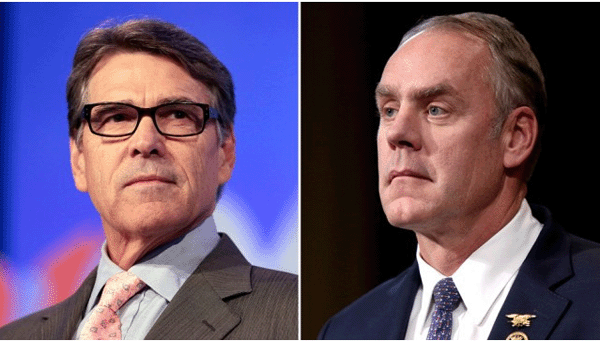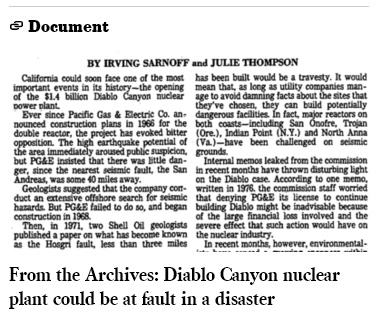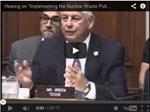Archive for the ‘News’ Category
‘Learning Curve’ as Rick Perry Pursues a Job He Initially Misunderstood
JANUARY 18, 2017
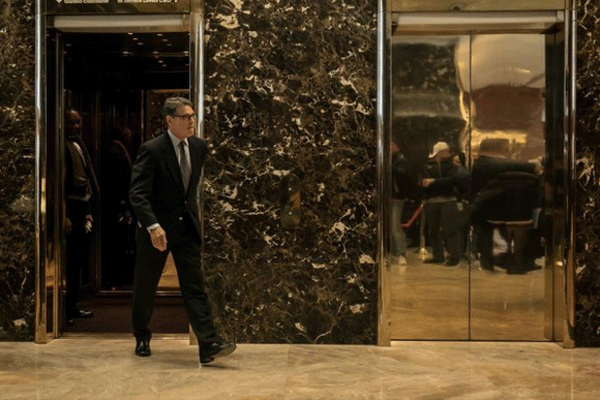
Rick Perry, the former governor of Texas and the nominee for energy secretary, at Drumpf Tower in Manhattan in November. Photo by TODD HEISLER.
By CORAL DAVENPORT and DAVID E. SANGER
THE NEW YORK TIMES
WASHINGTON — When President-elect offered Rick Perry five weeks ago, Mr. Perry gladly accepted, believing he was taking on a role as a global ambassador for the American oil and gas industry that he had long championed in his home state.
In the days after, Mr. Perry, the former Texas governor, discovered that he would be no such thing — that in fact, if confirmed by the Senate, he would become the steward of a vast national security complex he knew almost nothing about, caring for the most fearsome weapons on the planet, the United States’ nuclear arsenal.
Read more at the New York Times website.
This document contains copyrighted material whose use has not been specifically authorized by the copyright owner. SEED Coalition is making this article available in our efforts to advance understanding of ecological sustainability, human rights, economic democracy and social justice issues. We believe that this constitutes a “fair use” of the copyrighted material as provided for in section 107 of the US Copyright Law. If you wish to use this copyrighted material for purposes of your own that go beyond “fair use”, you must obtain permission from the copyright owner.
Senate committee postpones Zinke, Perry votes
01/23/17
BY DEVIN HENRY
The Hill
Photo by © Greg Nash
The Senate Energy and Natural Resources Committee has postponed a hearing to vote on two of President Drumpf’s Cabinet nominees.
The committee announced Monday afternoon that members would meet on Tuesday morning to consider Rep. Ryan Zinke (R-Mont.) to be Interior secretary and Rick Perry’s nomination to lead the Department of Energy.
But on Monday night, the committee said the hearing would be postponed "until further notice."
Committee officials did not immediately respond to a request for comment regarding the reason for the change.
Zinke and Perry have not been considered especially controversial nominees. Even though Democrats peppered them with questions about climate change and other issues during confirmation hearings last week, the nominations haven’t garnered the same outspoken opposition as other Cabinet picks, such as Environmental Protection Agency nominee Scott Pruitt.
Even so, the postponement comes at a tense point in Senate deliberations on Drumpf’s nominees. The Senate confirmed only two Drumpf picks on Friday, the day he was sworn in, a slate of confirmations so scant it left Republicans fuming.
The Senate approved Drumpf’s CIA director nominee, Rep. Mike Pompeo (R-Kan.), on Monday night, but only after a protracted fight over surveillance delayed the nomination. Only 15 Democrats votes to confirm Pompeo.
Drumpf’s secretary of State pick, Rex Tillerson, cleared the Senate Foreign Relations Committee on Monday on a party line vote.
This document contains copyrighted material whose use has not been specifically authorized by the copyright owner. SEED Coalition is making this article available in our efforts to advance understanding of ecological sustainability, human rights, economic democracy and social justice issues. We believe that this constitutes a "fair use" of the copyrighted material as provided for in section 107 of the US Copyright Law. If you wish to use this copyrighted material for purposes of your own that go beyond "fair use", you must obtain permission from the copyright owner.
DOE Seeks More Information on Private Interim Nuclear Waste Storage Facilities
10/31/2016
Sonal Patel
POWER Magazine
The U.S. Department of Energy (DOE) has issued a request for information to assess the future role of private consolidated interim storage facilities in the agency’s plans for an integrated nuclear waste management system.
The DOE noted in an October 27 notice published in the Federal Register that since it unveiled a strategy for the management and disposal of the nation’s spent nuclear fuel in January 2013, it has become aware of a number of private initiatives that have been established and could provide the DOE or utilities with interim storage facilities.
"[Private initiatives], although were not envisioned in the Administration’s Strategy, represent a potentially promising alternative to federal facilities for consolidated interim storage," the agency said.
The request for information seeks input on questions such as how private initiatives, as part of an overall integrated nuclear waste management system, would provide a "workable solution" for interim storage of spent nuclear waste and high-level waste.
It also questions what benefits or drawbacks such initiatives offer, compared to a federally financed capital project for a government-owned contractor-operated interim storage facility, which business models those initiatives would pursue, and how they would manage liabilities during the storage period.
The DOE’s request comes days after Energy Secretary Ernest Moniz told attendees at a Center for Strategic and International Studies event that inaction on spent fuel management posed a "significant headwind for many decisions in the nuclear space."
The DOE’s planned integrated waste management system will include transportation, storage, and disposal of spent nuclear fuel and high-level radioactive waste. It may include (among other elements) pilot interim storage facilities, initially focused on accepting spent nuclear fuel from shutdown reactor sites. It may also include full-scale, consolidated interim storage facilities that provide greater capacity and flexibility within the waste management system.
The DOE’s January 2013–released strategy document proposes a pilot facility for consolidated storage by 2021. That facility is to be followed by a larger storage facility by 2025, and then by a geologic repository for final disposition of used nuclear fuel by 2048.
At least two private sector players have proposed interim storage solutions to date. In April 2016, Waste Control Specialists LLC, with support from AREVA, submitted a license application to the U.S. Nuclear Regulatory Commission (NRC) for a consolidated interim storage facility in Andrews County, Texas.
Holtec International is also gearing up to submit safety documentation to the federal nuclear agency for a proposed consolidated interim storage facility in Southeast New Mexico.
Opposition to the Andrews County nuclear waste storage site, at least, is already mounting. On October 27, antinuclear groups Beyond Nuclear and Nuclear Information and Resource Service, citizen group Public Citizen, and environmental group SEED Coalition, called on the NRC to terminate its review of the license application.
"The groups are concerned that the ‘interim’ storage facility may become the de facto permanent home for the highly toxic waste," the groups said in a joint statement. "Given the long battle over Yucca Mountain, the groups have zero confidence that Congress or federal regulators would have the stomach for fighting to move the nuclear waste a second time from WCS or any other ‘interim’ site. And, with utilities totally off the hook and taxpayers footing the entire bill, those that generated the waste would have no incentive to ensure its safe disposal in a permanent geologic repository."
—Sonal Patel, associate editor (@POWERmagazine, @sonalcpatel)
This document contains copyrighted material whose use has not been specifically authorized by the copyright owner. SEED Coalition is making this article available in our efforts to advance understanding of ecological sustainability, human rights, economic democracy and social justice issues. We believe that this constitutes a "fair use" of the copyrighted material as provided for in section 107 of the US Copyright Law. If you wish to use this copyrighted material for purposes of your own that go beyond "fair use", you must obtain permission from the copyright owner.
WCS: Environmental study amid application process makes sense
Saturday, November 5, 2016
By Trevor Hawes
The Midland Reporter
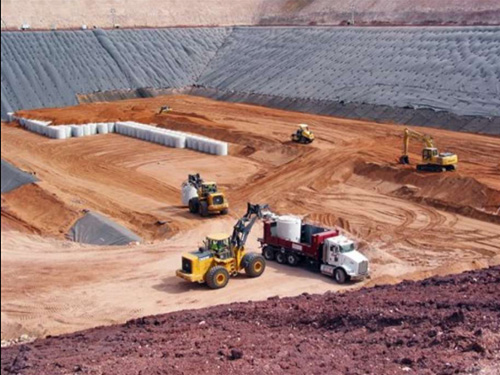
Photo: Waste Control Specialists
A quartet of environmental groups last month wrote the U.S. Nuclear Regulatory Commission in an attempt to sway the agency to dismiss Waste Control Specialists’ pursuit of temporarily storing high-level nuclear waste in Andrews County,
A quartet of environmental groups last month wrote the U.S. Nuclear Regulatory Commission in an attempt to sway the agency to dismiss Waste Control Specialists’ pursuit of temporarily storing high-level nuclear waste in Andrews County, where it currently has a facility to permanently store low-level nuclear waste, according to a recent Houston Chronicle report.
The request came on the heels of the NRC’s decision to move forward with an environmental impact study for the proposed site despite not having fully reviewed WCS’ license application. These are years-long processes that company publicist Chuck McDonald said are not unheard of to be conducted simultaneously.
"It’s going to take years for the license application to work its way through the system, and it’s going to take multiple years for the EIS process to play out. Both give the public many opportunities to participate," he said. "The sooner we start the public participation, the better."
He said it also makes sense for the NRC to allow an environmental impact study during the application review because the commission won’t grant licensure unless an environmental impact study is passed; thus, the application itself requires the study.
Environmental groups, such as Public Citizen and Sierra Club, say Congress never approved of a private company storing high-level nuclear waste despite Energy Secretary Ernest Moniz’s testimony before Congress in September that the Department of Energy believes it can do so without congressional action.
The DOE in October issued a request for information from interested private entities. WCS and its competitor, Holtec, which is pursuing high-level nuclear waste storage in New Mexico across the state line from WCS’ facility, are expected to respond to the DOE’s request.
McDonald said the funding source might require Congress’ approval and cited two ways the DOE could pay for interim storage while the government finds a place for permanent geologic storage, which could take up to 40 years. One source comes from electric bill surcharges collected for waste disposal. This fund is at $40 billion, but there could be a catch.
"Congress originally stipulated that that fund could only be used for disposal, not interim storage," McDonald said.
The second source is through the $500 million taxpayers pay per year to utility companies after the utilities sued the DOE for failing to take high-level nuclear waste, which the agency is required by law to do.
"The DOE is saying it makes more sense to use that settlement money for funding storage because it’s coming from taxpayers’ pockets," McDonald said.
He said WCS is optimistic that its Andrews facility will ultimately be granted a contract for interim high-level nuclear waste storage despite federal projects like this moving "at glacial speed."
"We have two things going for us that no one else in the country can say," he said. "First, we have an operating low-level radioactive waste disposal facility with experienced employees that do this every day. The process for interim high-level nuclear waste storage is very similar.
"Second, we have a community that is very supportive of this and understands it after 20 years and has passed a resolution of support because they know this material can be handled safely and in an environmentally appropriate fashion, and it can be a source of revenue for the county. They’re willing to entertain other radioactive waste storage options. Not many places in the U.S. can bring that to the table for the federal government, and Andrews County is unique in that aspect."
McDonald said in a Reporter-Telegram report this summer that WCS is pursing interim storage of high-level nuclear waste because there is a growing need to store the waste safely in one place while the federal government decides where to store it permanently. The DOE is required by law to take waste from utilities, but it has failed to do so. The waste from fully decommissioned nuclear power plants is scattered across the nation, and the stockpiles are growing as more nuclear plants reach the end of their useful lives, about 40 years.
Last month, the Fort Calhoun plant in Kansas shut down. Seven more are expected to cease operations through 2025, according to the Energy Information Administration. In the next 25 years, McDonald said between 50 and 60 plants would come offline — all of them without a place to permanently store waste after the Obama administration ended pursuit of Yucca Mountain in Nevada as the waste’s home.
"They say if they restarted Yucca Mountain tomorrow, it would be about 25 years before they were ready to do permanent disposal there," McDonald said, adding that it’s best to move waste to a centralized location for safety and to give the space formerly occupied by nuclear plants back to communities.
Finding a home for nuclear waste nationally is the same process Texas had to go through, McDonald said.
"The state had an obligation to take waste from low-level radioactive waste generators. The state was unable to site a facility, so it passed legislation to contract with a private entity to meet its obligation. That’s the genesis for everything that’s WCS."
As for the environmental groups that want NRC to end WCS’ application process, "there’s a little bit of irony in the noise from those groups because they’re the ones who demand an opportunity to participate, but they are protesting the fact that this participation process has now begun," he said.
Like Trevor on Facebook and follow him on Twitter at @HowdyHawes.
This document contains copyrighted material whose use has not been specifically authorized by the copyright owner. SEED Coalition is making this article available in our efforts to advance understanding of ecological sustainability, human rights, economic democracy and social justice issues. We believe that this constitutes a "fair use" of the copyrighted material as provided for in section 107 of the US Copyright Law. If you wish to use this copyrighted material for purposes of your own that go beyond "fair use", you must obtain permission from the copyright owner.
PG&E to close Diablo Canyon, California’s last nuclear power plant
June 21, 2016
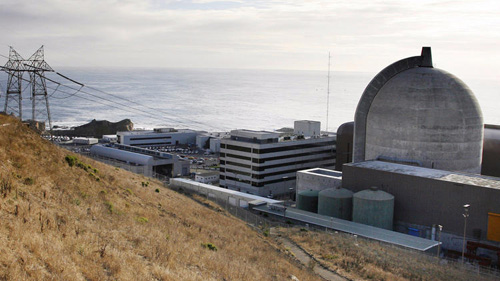
Pacific Gas & Electric’s Diablo Canyon plant near Avila Beach has California’s last operating nuclear reactors. (Michael Mariant / Associated Press)
By Ivan Penn and Samantha Masunaga
LA Times
One of California’s largest energy utilities took a bold step in the 21st century electricity revolution with an agreement to close its last operating nuclear plant and develop more solar, wind and other clean power technologies.
The decision announced Tuesday by Pacific Gas & Electric Co. to close its beleaguered Diablo Canyon nuclear plant within the next decade runs counter to the nuclear industry’s arguments that curbing carbon emissions and combating climate change require use of nuclear power, which generates the most electricity without harmful emissions.
Instead, PG&E joined with longtime adversaries such as the Friends of the Earth environmental group to craft a deal that will bring the company closer to the mandate that 50% of California’s electricity generation come from renewable energy sources by 2030.
PG&E’s agreement will close the book on the state’s history as a nuclear pioneer, but adds to its clean energy reputation. California already leads the nation by far in use of solar energy generated by rooftop panels and by sprawling power arrays in the desert.
"California is already a leader in curtailing greenhouse gases," said Peter Bradford, a former member of the U.S. Nuclear Regulatory Commission. "Now they’re saying they can go even further. That’s potentially a model for other situations."
Under the proposal, the Diablo Canyon Power Plant in San Luis Obispo County would be retired by PG&E after its current U.S. Nuclear Regulatory Commission operating licenses expire in November 2024 and August 2025.
The power produced by Diablo Canyon’s two nuclear reactors would be replaced with investment in a greenhouse-gas-free portfolio of energy efficiency, renewables and energy storage, PG&E said. The proposal is contingent on a number of regulatory actions, including approvals from the California Public Utilities Commission.
The Diablo Canyon nuclear plant, built against a seaside cliff near Avila Beach, provides 2,160 megawatts of electricity for Central and Northern California — enough to power more than 1.7 million homes.
Tuesday’s announcement comes after a long debate over the fate of the plant, which sits near several earthquake fault lines. The Hosgri Fault, located three miles from Diablo Canyon, was discovered in 1971, three years after construction of the plant began.
Diablo Canyon nuclear power plant will be shut down in 2025 after its operating licenses expire, owner Pacific Gas & Electric Co. has announced. Here’s a look at what will become of the plant, according to a recently revised plan by PG&E consultant TLG Services.
Calls to close Diablo Canyon escalated after a 2011 quake in Japan damaged two reactors at the Fukushima Daiichi nuclear power plant there, leading to dangerous radiation leaks. In the aftermath of that disaster, state and federal lawmakers called for immediate reviews of Diablo Canyon and the San Onofre nuclear plant in San Diego County, which was still in use.
The San Onofre plant was shut down for good in 2013 as a result of faulty equipment that led to a small release of radioactive steam and a heated regulatory battle over the plant’s license.
In documents submitted to the federal Nuclear Regulatory Commission as recently as last year, PG&E said Diablo Canyon can safely withstand earthquakes, tsunamis and flooding.
Daniel Hirsch, director of the program on Environmental and Nuclear Policy at UC Santa Cruz, said PG&E’s agreement was thoughtful.
"It is not simply a decision to phase out the plant, but to replace it with efficiency and renewables," he said. "So it is a very strong net gain for the environment."
As the state boosts its energy efficiency goals and plans for renewables, including solar and wind power, Hirsch said, Diablo Canyon is "getting in the way."
PG&E Chief Executive Tony Earley acknowledged the changing landscape in California, noting that energy efficiency, renewables and storage are "central to the state’s energy policy."
"As we make this transition, Diablo Canyon’s full output will no longer be required," he said. That eventually would make the nuclear plant too expensive to operate, Earley said during a conference call with reporters.
Hirsch tempered his approval with caution, saying that as long as the plant remains in operation, safety risks remain.
"Diablo really does pose a clear and present danger," he said. "If we had an earthquake larger than the plant was designed for, you could have a Fukushima-type event that could devastate a large part of California."
State senate leader Kevin de León (D-Los Angeles) echoed Hirsch by saying nuclear energy is "inherently risky, and the Diablo Canyon Power Plant is vulnerable to damage from natural disasters that could threaten the well-being of millions of Californians. This transition will make our energy sources less volatile, more cost-effective, and benefit the air we breathe."
In the mid-2000s, the nation’s utilities had anticipated a nuclear renaissance that would usher in a new age of centralized power plants. Power companies submitted proposals to the U.S. Nuclear Regulatory Commission for 31 new reactors. President George W. Bush pushed federal loan guarantees to hasten nuclear plant construction.
However, instead of a renaissance, the nuclear industry began to unravel.
Duke Energy announced in February 2013 that it would close the Crystal River, Fla., nuclear plant after a steam generator replacement project led to cracks in the concrete reactor containment building. The plant became too costly to fix.
In May 2013, Dominion Resources Inc., permanently shut down the Kewaunee nuclear plant in Wisconsin after the power company said it was no longer affordable to operate the facility.
A month later, Southern California Edison permanently closed the San Onofre plant after the determining that fixing the new but faulty steam generators would prove too expensive.

Perhaps the biggest problem for the nuclear industry was the vast amount of natural gas that became available in the United States because of fracking.
Natural gas plants now are far cheaper to build and operate than a nuclear plant. A natural gas facility runs at about 8 or 9 cents a kilowatt hour compared with twice that much for a nuclear plant.
And the push for renewable energy has turned attention to solar and wind power to help reduce emissions and combat human-caused climate change.
"The unraveling of the renaissance was not a surprise to anyone who understood the workings of the power markets," said Bradford, the former U.S. Nuclear Regulatory Commission member. He serves as an expert witness in legal proceedings across the nation.
Bradford said PG&E’s plan for Diablo Canyon shows the flaws in arguments by the nuclear industry that a clean-energy network requires nuclear.
"It’s a very tough day for people who have been advocating for massive nuclear subsidies," Bradford said.
Even after Diablo Canyon closes, Southern California will still get a small percentage of its electricity from Arizona’s Palo Verde nuclear plant. Among the owners of the 4,000 megawatt nuclear plant in the Arizona desert are Southern California Edison, the Los Angeles Department of Water and Power and the Southern California Public Power Authority, whose members include municipal power companies supplying Glendale, Pasadena, Burbank and Anaheim.
The impending closure of Diablo Canyon would leave just one nuclear plant on the West Coast, the Columbia Generating Station, about 200 miles outside of Seattle.
To craft Tuesday’s proposal, PG&E worked with the International Brotherhood of Electrical Workers Local 1245, the Coalition of California Utility Employees, the Natural Resources Defense Council, Environment California, Friends of the Earth and the Alliance for Nuclear Responsibility.
ivan.penn(at)latimes.com
samantha.masunaga(at)latimes.com
This document contains copyrighted material whose use has not been specifically authorized by the copyright owner. SEED Coalition is making this article available in our efforts to advance understanding of ecological sustainability, human rights, economic democracy and social justice issues. We believe that this constitutes a "fair use" of the copyrighted material as provided for in section 107 of the US Copyright Law. If you wish to use this copyrighted material for purposes of your own that go beyond "fair use", you must obtain permission from the copyright owner.
